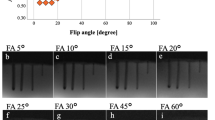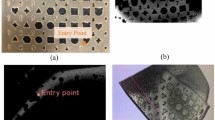Abstract
In this article, we study in vitro evaluation of needle artefacts and image quality for musculoskeletal laser-interventions in an open high-field magnetic resonance imaging (MRI) scanner at 1.0T with vertical field orientation. Five commercially available MRI-compatible puncture needles were assessed based on artefact characteristics in a CuSO4 phantom (0.1%) and in human cadaveric lumbar spines. First, six different interventional sequences were evaluated with varying needle orientation to the main magnetic field B0 (0° to 90°) in a sequence test. Artefact width, needle-tip error, and contrast-to-noise ratio (CNR) were calculated. Second, a gradient-echo sequence used for thermometric monitoring was assessed and in varying echo times, artefact width, tip error, and signal-to-noise ratio (SNR) were measured. Artefact width and needle-tip error correlated with needle material, instrument orientation to B0, and sequence type. Fast spin-echo sequences produced the smallest needle artefacts for all needles, except for the carbon fibre needle (width <3.5 mm, tip error <2 mm) at 45° to B0. Overall, the proton density-weighted spin-echo sequences had the best CNR (CNRMuscle/Needle >16.8). Concerning the thermometric gradient echo sequence, artefacts remained <5 mm, and the SNR reached its maximum at an echo time of 15 ms. If needle materials and sequences are accordingly combined, guidance and monitoring of musculoskeletal laser interventions may be feasible in a vertical magnetic field at 1.0T.





Similar content being viewed by others
References
Schulz T, Puccini S, Schneider JP Kahn T (2004) Interventional and intraoperative MR: review and update of techniques and clinical experience. Eur Radiol 14(12):2212–2227
Smith KA, Carrino J (2008) MRI-guided interventions of the musculoskeletal system. J Magn Reson Imaging 27(2):339–346
Fritz J, Clasen S, Boss A et al (2008) Real-time MR fluoroscopy-navigated lumbar facet joint injections: feasibility and technical properties. Eur Radiol 18(7):1513–1518
de Senneville BD, Mougenot C, Quesson B, Dragonu I, Grenier N, Moonen CT (2007) MR thermometry for monitoring tumor ablation. Eur Radiol 17(9):2401–2410
Streitparth F, Walter T, Wonneberger U (2009) Image-guided spinal injection procedures in open high-field MRI with vertical field orientation: feasibility and technical features. Eur Radiol (in press)
Fritz J, Pereira PL (2007) MR-guided pain therapy: principles and clinical applications. Rofo 179(9):914–924
Steiner P, Zweifel K, Botnar R et al (1998) MR guidance of laser disc decompression: preliminary in vivo experience. Eur Radiol 8(4):592–597
Streitparth F, Gebauer B, Melcher I et al (2009) MR-guided laser ablation of osteoid osteoma in an open high-field system (1.0 T). Cardiovasc Intervent Radiol 32(2):320–325
American Society for Testing and Materials (ASTM) (2001) Designation: F 2119-01—standard test method for evaluation of MR image artifacts from passive implants. ATSM, West Conshohocken
Frahm C, Gehl HB, Melchert UH, Weiss HD (1996) Visualization of magnetic resonance-compatible needles at 1.5 and 0.2 Tesla. Cardiovasc Intervent Radiol 19(5):335–340
DiMaio SP, Kacher DF, Ellis RE et al (2006) Needle artifact localization in 3T MR images. Stud Health Technol Inform 119:120–125
Altman DG, Bland JM (1996) Comparing several groups using analysis of variance. Br Med J (Clin Res Ed) 312(7044):1472–1473
Quesson B, de Zwart JA, Moonen CT (2000) Magnetic resonance temperature imaging for guidance of thermotherapy. J Magn Reson Imaging 12(4):525–533
Ladd ME, Erhart P, Debatin JF, Romanowski BJ, Boesiger P, McKinnon GC (1996) Biopsy needle susceptibility artifacts. Magn Reson Med 36(4):646–651
Lewin JS, Duerk JL, Jain VR, Petersilge CA, Chao CP, Haaga JR (1996) Needle localization in MR-guided biopsy and aspiration: effects of field strength, sequence design, and magnetic field orientation. AJR 166(6):1337–1345
Liu H, Hall WA, Martin AJ, Truwit CL (2001) Biopsy needle tip artifact in MR-guided neurosurgery. J Magn Reson Imaging 13(1):16–22
Liu H, Martin AJ, Truwit CL (1998) Interventional MRI at high-field (1.5 T): needle artifacts. J Magn Reson Imaging 8(1):214–219
Ludeke KM, Roschmann P, Tischler R (1985) Susceptibility artefacts in NMR imaging. Magn Reson Imaging 3(4):329–343
Muller-Bierl B, Graf H, Lauer U, Steidle G, Schick F (2004) Numerical modeling of needle tip artifacts in MR gradient echo imaging. Med Phys 31(3):579–587
Muller-Bierl B, Graf H, Steidle G, Schick F (2005) Compensation of magnetic field distortions from paramagnetic instruments by added diamagnetic material: measurements and numerical simulations. Med Phys 32(1):76–84
Reichenbach JR, Wurdinger S, Pfleiderer SO, Kaiser WA (2000) Comparison of artifacts produced from carbon fiber and titanium alloy needles at 1.5 T MR imaging. J Magn Reson Imaging 11(1):69–74
Farahani K, Sinha U, Sinha S, Chiu LC, Lufkin RB (1990) Effect of field strength on susceptibility artifacts in magnetic resonance imaging. Comput Med Imaging Graph 14(6):409–413
Chopra SS, Rump J, Schmidt SC et al (2009) Imaging sequences for intraoperative MR-guided laparoscopic liver resection in 1.0-T high field open MRI. Eur Radiol. doi:10.1007/s00330-009-1393-7
Ishiwata Y, Takada H, Gondo G, Osano S, Hashimoto T, Yamamoto I (2007) Magnetic resonance-guided percutaneous laser disk decompression for lumbar disk herniation—relationship between clinical results and location of needle tip. Surg Neurol 68(2):159–163
Schoenenberger AW, Steiner P, Debatin JF et al (1997) Real-time monitoring of laser diskectomies with a superconducting, open-configuration MR system. AJR 169(3):863–867
Steiner P, Schoenenberger AW, Erhart P, Penner E, von Schulthess GK, Debatin JF (1997) Imaging temperature changes in an interventional 0.5 T magnet: in-vitro results. Lasers Surg Med 21(5):464–473
Wlodarczyk W, Hentschel M, Wust P et al (1999) Comparison of four magnetic resonance methods for mapping small temperature changes. Phys Med Biol 44(2):607–624
Acknowledgments
This project was financed by a public grant (TSB Technologiestiftung Berlin—Zukunftsfonds, Berlin, Germany) and cofinanced by the European Union—European Fund for Regional Development (Project No. 10132816/10134231).
Author information
Authors and Affiliations
Corresponding author
Rights and permissions
About this article
Cite this article
Wonneberger, U., Schnackenburg, B., Streitparth, F. et al. Evaluation of Magnetic Resonance Imaging-Compatible Needles and Interactive Sequences for Musculoskeletal Interventions Using an Open High-Field Magnetic Resonance Imaging Scanner. Cardiovasc Intervent Radiol 33, 346–351 (2010). https://doi.org/10.1007/s00270-009-9676-6
Received:
Revised:
Accepted:
Published:
Issue Date:
DOI: https://doi.org/10.1007/s00270-009-9676-6




